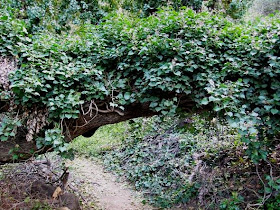
Wednesday, Mar 17.
This hike is out of Chantry Flats, which is at the top of Santa Anita Avenue, above Arcadia and Sierra Madre. Parking at Chantry requires an Adventure Pass (either a five dollar day pass or $30 for an "annual" pass). Adventure Pass covers entry into fee areas in the Angeles, Cleveland, Los Padre or San Bernadino National Forests.
Since I bought my pass last month, it'll be good until the end of February 2011. Since purchasing my pass, this was my sixth hike that originated out of a fee area, which means it was my "break even" hike.
Two days later, I took my seventh hike out of a fee area covered by my Adventure Pass, so now I'm "ahead" on the Adventure Pass. However, I'm still debating whether I should have gone and splurged for an "America the Beautiful" pass, which would have cost $50 more but would cover unlimited entry into all USDA Forest Service, National Park Service, BLM or U.S. Fish and Wildlife Service areas that charge a day-use fee. I haven't gone into any of those other fee areas since February, but I figured I'll be hitting at least Joshua Tree soon. Depending on my summer travel, I might also make it up to Yosemite, Zion or Bryce National Parks (or others), and possibly Red Rock Canyon National Conservation Area or the Spring Mountains National Recreation Area (both outside of Las Vegas).
Today's hike was just for the exercise. I've hiked on all of these trails over the past few months.
Lower Winter Creek is accessed by heading down the same paved trail you'd take to get to Sturdevant Falls. When the pavement ends and you cross the creek over a bridge, there's a restroom. There's also a trail sign indicating directions and mileage to various points of interest. Going on the Lower Winter Creek trail requires a left turn, pass one of many unattractive flood and erosion control structures that were built in the 1960s. Not far after that, you pass a number of cabins.
In this canyon, as in many along the San Gabriel Mountains, cabins were built and occupied from at least the middle 1800s. Occupants apparently decided they wanted familiar landscaping, so they planted ivy and periwinkle around their homes. Those non-native vines have largely taken over the floor of these canyons. Periwinkle blossoms are attractive, at least, but I'm pretty sure that neither periwinkle nor ivy provides any food for our native wildlife.

Ivy, overgrowing a downed oak

Periwinkle flower
A little under 2 miles from the junction with the Sturdevant Trail, you reaches Hoagee's Camp. Yep, people actually camp here. Personally, I don't like backpack camping within range of easy dayhiking, but I supppose it does give folks a chance to practice their backpacking skills closer to home.
The Lower Winter Creek trail continues through Hoegees. An 1/8 of a mile later, you reach the junction with the Mt. Zion Trail. The signage at this junction seems to suggest this is also the "official" dividing line between the Upper and Lower Winter Creek trails. The sign also tells you that it's 1 1/4 mile to the summit of Mt. Zion, two miles if you backtrack from here back along the Lower Winter Creek trail to Chantry Flats, or three miles if you continue forward along the Upper Winter Creek trail to Chantry Flats. I'm not sure how accurate these sign mileages are, but it does tell you that the basic loop is about five miles long, while the loop with a Mt. Zion detour is about seven miles.

Mt. Zion is not exactly a towering pinnacle. Indeed, it's not really much of a summit, at all. It's just sort of a slightly higher bump along a ridge. You're largely surrounded by Manzanita bush along the last bit. It's nearing the end of the bloom for that.

Next to the mazanita flowers, you can see a cluster of "fruit." Those look like little apples--Hence, the name of the plant, which is Spanish for "little apple."
Other flowers I saw along the way are pictured below. Not sure about most of the species, except for the wallflower that I previously saw on my hike up Little Santa Anita Canyon.


No comments:
Post a Comment